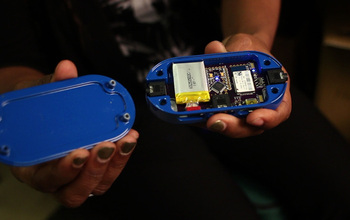![]()
Media Advisory 14-007
Innovation Corps leaders converge to discuss how to build on program’s success![]()
National Innovation Network participants to plot path forward, aim to expand positive economic impact
|
NSF-funded researchers learn during I-Corps whether there is a market for their technology. |
April 8, 2014
In 2011, the National Science Foundation (NSF) created the Innovation Corps (I-Corps™) program to train NSF-funded researchers to evaluate their scientific discoveries for commercial potential.
Next week, I-Corps participants from across the country will meet in Bethesda, Md., to discuss the progress made, lessons learned and opportunities for growth.
Who:
Key leaders include:
- Steve Blank, retired serial entrepreneur, author and professor, will be the keynote speaker at the event. The I-Corps curriculum is modeled on the Lean LaunchPad entrepreneurship course Blank created at Stanford University.
- Farnam Jahanian, NSF Assistant Director, leads the Directorate for Computer and Information Science and Engineering.
- Pramod Khargonekar, NSF Assistant Director, leads the Directorate for Engineering.
- Phil Weilerstein, NCIIA Executive Director.
Why:
Since I-Corps’ inception, about 115 institutions and 296 teams, with about three people each, have participated in the program. I-Corps gives NSF-funded researchers access to industry experts and hands-on immersive learning. As a result, I-Corps grantees are equipped to make informed decisions about the transition of NSF-funded research and development into the marketplace.
NSF and the U.S. Department of Energy have since begun a collaboration to enable ARPA-E grantees, who conduct research and development on advanced energy technologies, to participate in the NSF I-Corps program.
In 2013, NSF established the National Innovation Network (NIN) to further extend I-Corps’ reach and leverage the community that has developed among the grantees to increase the program’s impact. NIN brings together people and organizations engaged in I-Corps programming to create, use and sustain an innovation ecosystem that enhances the development of technologies, products and processes that benefit society.
The National Collegiate Inventors and Innovators Alliance (NCIIA) coordinates the programming and enables the creation and implementation of tools that support innovation and the emergence of STEM innovators while propagating effective innovation practices on a national scale through the network. At the meeting, NIN participants also plan to develop and define strategies for program optimization, graduate development, research and assessment.
When:
The meeting will take place April 10 and 11, 2014.
Media contacts:
Members of the press who would like to attend the meeting or set up an interview with Khargonekar or Jahanian, please contact Sarah Bates (703-292-7738; sabates@nsf.gov).
To speak with Blank, please contact Terri S. Vanech (203-918-1270; terri@kandsranch.com).
To speak with Weilerstein, please contact Jo Ellen Warner (202-420-9297; jwarner@nciia.org).
-NSF-
![]()
Media Contacts
Sarah Bates, NSF, (703) 292-7738, sabates@nsf.gov
![]()
The National Science Foundation (NSF) is an independent federal agency that supports fundamental research and education across all fields of science and engineering. In fiscal year (FY) 2014, its budget is $7.2 billion. NSF funds reach all 50 states through grants to nearly 2,000 colleges, universities and other institutions. Each year, NSF receives about 50,000 competitive requests for funding, and makes about 11,500 new funding awards. NSF also awards about $593 million in professional and service contracts yearly.
Useful NSF Web Sites:
NSF Home Page: http://www.nsf.gov
NSF News: http://www.nsf.gov/news/
For the News Media: http://www.nsf.gov/news/newsroom.jsp
Science and Engineering Statistics: http://www.nsf.gov/statistics/
Awards Searches: http://www.nsf.gov/awardsearch/
![]()
